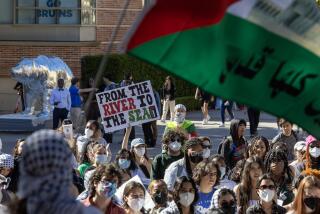Two Rabbis Have Israel Tied in Knots : Politics: At the heart of Labor’s inability to put together a coalition is the country’s deep division over its identity.
- Share via
Casual observers of Israeli politics must find this baffling: Two elderly rabbis--one has never set foot in Israel, neither has held political office--have prevented Shimon Peres from forming a government and pursuing the peace process with the Palestinians. Even more baffling is that the two rabbis, Rabbi Shach, 93, and Rabbi Schneerson, 88, hold diametrically opposite views on the peace process and have been bitter enemies for years. What unites them, paradoxically, is their condemnation of Zionism and aversion to the Labor Party.
The source of the two sages’ power is, of course, the influence they wield over Israel’s ultra-orthodox Jewish political parties. Holding 13 of 120 Knesset seats, these parties are crucial for the formation of Israel’s next coalition government.
Rabbi Shach, head of the Ponivezh yeshiva, is the spiritual leader of two political parties: the mostly Sephardic Shas, with six seats in the Knesset, and the Ashkenazi Torah Flag, with two. Rabbi Schneerson--the Lubavitcher Rebbe--heads the Brooklyn-based Hasidic sect of Chabad. In the 1988 Israeli elections, Schneerson supported the third ultra-orthodox party, Agudat Yisrael, which helped it increase its Knesset membership from two to five seats.
Many Israelis would like to diminish the orthodox parties’ power by changing the electoral system. One of the two major parties, Labor or Likud, would then be better able to govern effectively. Changing the political rules, however, would not do away with the fundamental social reality that underlies the current political deadlock: Israeli society is deeply divided over the definition of its own collective identity.
When it was founded at the end of the 19th Century, the Zionist movement aimed to present a secular, national alternative to the traditional Jewish way of life. But to appeal to the Jewish masses, particularly in Eastern Europe, Zionism had to borrow its symbols from traditional Jewish culture. Thus, the Star of David, the menorah, the idea of aliyah (pilgrimage) to Zion and many other religious symbols were infused with a secular and national content.
While borrowing the symbols of traditional Judaism, Zionism could not ignore the religious institutions that still commanded the allegiance of the vast majority of Jews. Since orthodox Jewry was largely anti-Zionist, orthodox groups willing to cooperate with the Zionist movement were granted a privileged status within it.
By the mid-1930s, the Labor Zionist movement was the dominant force in Zionism. It carried on the policy of trying to accommodate the representatives of orthodox Jewry, and for the same reasons. Thus, when the Israeli government under Ben Gurion nationalized Israel’s schools in the early 1950s, only two of the previously existing systems were allowed to continued to operate: the independent system of Agudat Yisrael and one under the de-facto control of the National Religious Party.
The religious school systems, and a whole network of state-subsidized yeshivot (many of whose students have been exempt from mandatory military service) have been promoting a principle of collective identity based exclusively on Jewish ethnicity. According to this principle, the only meaningful political distinction is that between Jews and non-Jews.
In contrast, official Israeli identity as defined by the state is much more ambiguous. While Israel is considered, by law, to be a Jewish state, Israeli citizenship rights can be enjoyed by non-Jews as well. Thus, the 18% of Israeli citizens who are Arab are supposed to have all the rights and privileges accorded to Jews.
The clash between these two principles of identity is evident now in Jerusalem, where Jewish settlers, at the behest of government officials, have been living in the Christian quarter since Easter week. Israel’s Supreme Court Thursday ordered them evicted.
In recent years, the Jewish principle of identity has been gaining ground, for two important reasons: The continuation and increasing intensity of the Israeli-Palestinian conflict have resulted in greater solidarity among Jews and greater hostility toward Arabs; and Sephardic Jews, who have been economically, politically and culturally barred from the mainstream of Israeli society, have responded to this exclusion by reasserting their Jewish identity.
Disaffected Sephardic Jews have flocked to Likud, the former opposition. As a result, the party, whose leadership is no more religiously observant than Labor’s, has become, through its rank-and-file members, the chief carrier of the Jewish principle of identity.
What distances the religious parties from Labor and unites them with Likud, then, is a much deeper schism than the ones usually recognized in Israeli politics. It has to do with the very definition of the society’s collective identity. It transcends such issues as territories vs. peace, Sephardi vs. Ashkenazi, Zionist vs. non-Zionist.
Although Rabbi Shach has frequently stated his preference for peace over territory, he has instructed his disciples not to form a coalition with Peres. In doing so, he alluded to the Labor Zionist movement’s historical disdain for traditional Jewish values. Similarly, Agudat Yisrael, which initially supported Peres, insisted that he forge a majority among Jewish members of the Knesset. When this proved impossible, given Rabbi Shach’s position, Peres’ efforts to form a Labor-led government were doomed.
The Israeli electorate is about equally divided between a Likud-led and a Labor-led bloc, with an additional 15% supporting religious parties. If the strength of religious parties is reduced through electoral reform, this will not break the deadlock between Labor and Likud. Even if an American-style presidential system is introduced, the president will still have to work with a deadlocked Knesset, which would prove an impossible task.
Israelis must decide whether they want to live in an open, democratic and forward-looking society, or whether they want a Jewish ghetto to be reconstructed in the Middle East. Until this decision is made, the political deadlock will continue. And no amount of political or electoral manipulation can change this reality.
More to Read
Get the L.A. Times Politics newsletter
Deeply reported insights into legislation, politics and policy from Sacramento, Washington and beyond. In your inbox twice per week.
You may occasionally receive promotional content from the Los Angeles Times.






